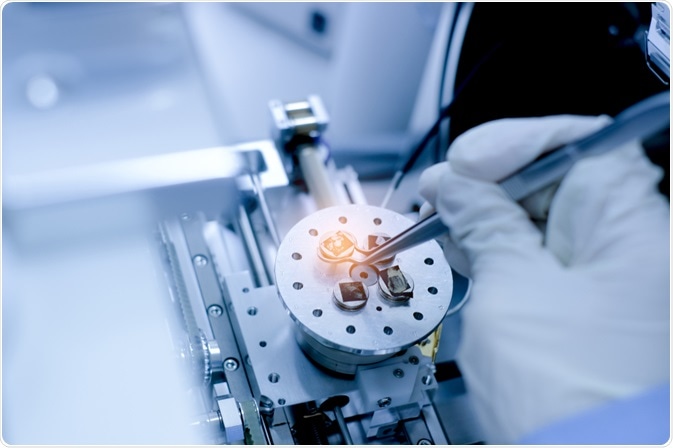Nanotechnology is the analysis and manipulation of nanoscale objects. There are typically two categories of objects in the nanoscale world. The first being micro-sized objects that are governed by the classical laws of mechanics and the second being the sub-microscopic objects affected by fluctuations in the laws of quantum mechanics.
The properties of the nano-scale objects can be utilized in various applications and technologies. As the size of objects decreases, surface-area effects become important and this has found applications in analytical chemistry. In addition, quantum effects lead to large changes in the properties of materials. These effects have led to applications in spectroscopy such as the scanning tunneling microscope. In contrast, a disadvantage of these quantum effects is found in the development of nano-scale electronic devices.

Image Credit: Anucha Cheechang/Shutterstock.com
Nanotechnology in analytical chemistry
There are typically two main applications for nanotechnology in analytical chemistry. The first is to analyze nano-scale material and the second is to use nanotechnology for analysis and in spectroscopic imagine. Spectroscopic instrumentation and other scanning microscopy techniques supplement the information provided by other techniques such as electron microscopy, atomic force microscopy, and scanning tunneling microscopy to help characterize the structure and function of molecules and chemical or biological objects.
Furthermore, nanotechnology has developed materials that have led to new analytical techniques.
Due to the complexity of the chemical and biological information within biological systems, it is often thought that a combination of different instruments should be used to capture the full complexity of the system, especially for chemical imaging. The main challenge in using such instrumentation is translating the nanoscale methods into medically or biologically relevant tools.
Applications of nanotechnology in analytical chemistry
Allotropy is the term given for the several structural forms an element can exhibit. Carb allotropes are the most commonly found, such as graphite and diamond. Carbon is very important for several technology applications. Buckminsterfullerene is a molecular structure consisting of a spherical arrangement of dozens of carbon atoms.
Fullerenes, named after Richard Buckminster Fuller, look like soccer balls and are also called ‘buckyballs’, whereas cylindrical fullerenes are called buckytubes or nanotubes. Fullerenes are often called C60 because this form is the most widely, but other geometric structures, such as C70, C76, C78, and C80, have also been characterized by Nuclear Magnetic Resonance (NMR). These fullerene structures play an important role in nanoscience and nanotechnology.
At present, graphene is a particularly fast-growing area of nanoscience and technology. Graphene has a 2-D hexagonal lattice of carbon atoms and has advantageous physical and chemical properties, which can be exploited for various applications.
Fullerenes are molecules composed entirely of carbon, shaped like hollow spheres or tubes, and are similar in structure to graphite. Fullerenes have many potential applications in imaging. Graphene, on the other hand, is a basic carbon allotrope that is isolated from graphite by mechanical exfoliation, which can form a one atom thick planar sheet of carbon atoms arranged in a honeycomb crystal lattice. The incredible properties of nanotubes and graphene lie within their atomically thin mesh-like structure of carbon atoms arranged in a hexagonal pattern.
Graphene has strong carbon-carbon bonds, which gives them a very high tensile strength. Additionally, the symmetry of the carbon atoms within graphene gives it low electrical resistance that allows for applications in electronics. Small changes in the carbon structure can create new properties in the molecules. The electronic property of graphene depends on the sheet size and the presence of defects in the lattice.
In addition, nanotubes can be semiconducting or metallic by simply changing their length and diameter. Graphene and other carbon allotropes have many applications in analytical chemistry such as sensitive spectroscopic instrumentation.
Nanotechnology in spectroscopy
Nanostructures have unusual interactions with light and play a big role in developing highly sensitive instrumentation. Different spectroscopic methods are important in nanotechnology for imaging of nanomaterials, and for investigating the electronic structure of nanostructured materials. One such application uses surface plasmon resonance, which occurs when light is in resonance with the free electrons of the metal surface. It is often detected by the coloration of nanoparticles, typically gold nanoparticles.
Gold nanoparticles can be used for increasing the detection limits of very low concentrations. This is because the gold nanoparticles scatter light efficiently, which makes them easier to detect with diffuse light scattering techniques. Surface-Enhanced Raman Scattering (SERS) spectroscopy can detect substances to the single-molecule level.
The SERS technique is currently limited because it is dependent on the metal substrate having a roughened surface of being in the form of a nanoparticle to achieve a strong Raman signal. However, there have been innovations to increase the signal by coating the gold nanoparticle with ultrathin silica or aluminum to amplify the Raman signal. The application for this technique is generally for the detection of drugs, explosives, and environmental pollutants.
Sources:
- M. Valcarcel, B.M. Simonet, Nanomaterials for improved analytical processes, Anal. Bioanal. Chem. 399 (1) (2011) 1–2.
- K. Kikuchi, et al., NMR characterization of isomers of C-78, C-82 and C-84 fullerenes, Nature 357 (6374) (1992) 142–145.
- R. Van Noorden, Chemistry: the trials of new carbon, Nat. Methods 469 (2011) 14–16.
- M. Qazi, T. Vogt, G. Koley, Trace gas detection using nanostructured graphite layers, Appl. Phys. Lett. 91 (23) (2007).
- O.R. Bolduc, J.F. Masson, Advances in surface plasmon resonance sensing with nanoparticles and thin films: nanomaterials, surface chemistry, and hybrid plasmonic techniques, Anal. Chem. 83 (21) (2011) 8057–8062.
Further Reading
Last Updated: Oct 5, 2021